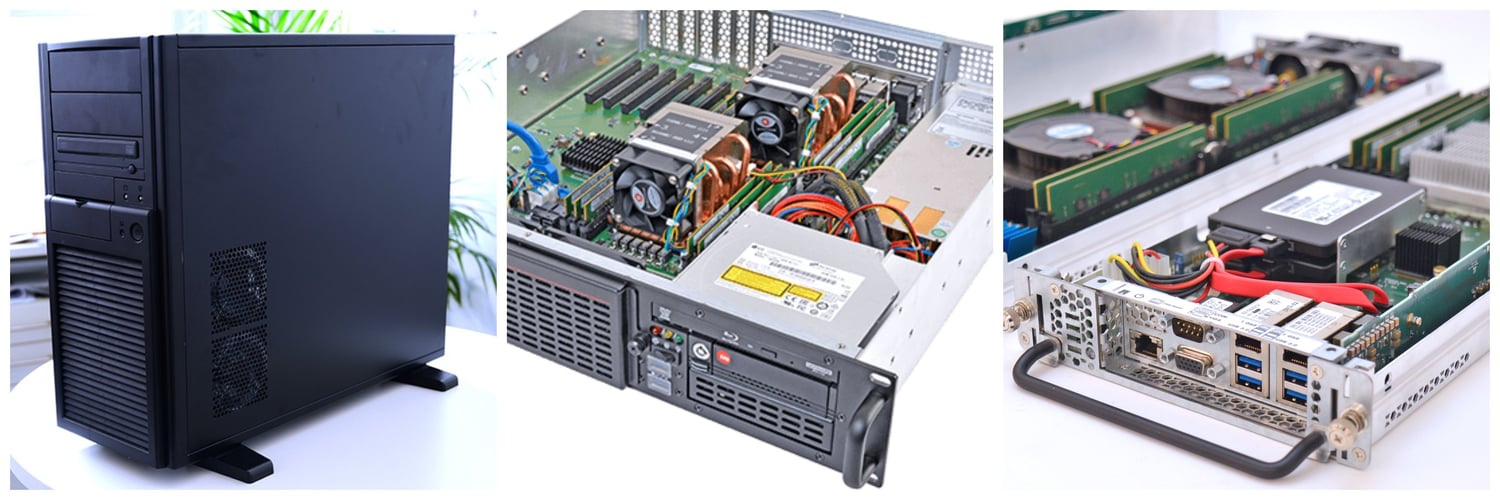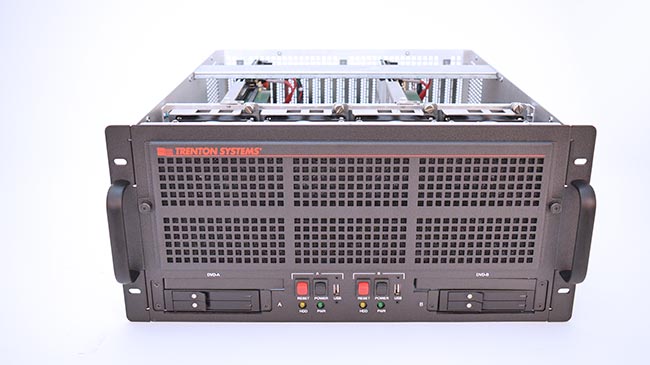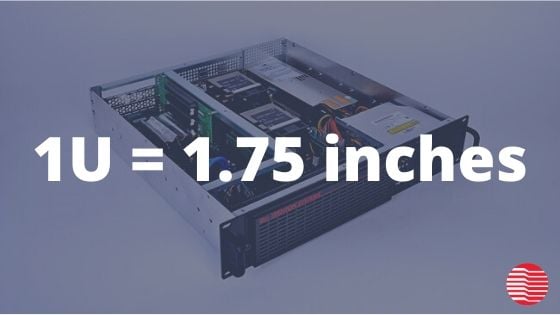Share this
What Is a Rack Server?
by Brett Daniel on May 7, 2020 11:05:50 AM
There are several types of rugged computers out there supporting a variety of different military, industrial and commercial applications. The most common, however, is the unmistakable rack server.
These slidable, hot-swappable, high-powered rugged computers are ideal for harsh environments and programs that emphasize space conservation, scalability, upgradability and expandability.
In this blog post, we'll discuss how a rack server works, the different sizes of rack servers and server racks, and how you can choose the best of both to fit your program or application.
What is a rack server?
A rack server, also known as a rack mount server, rack-mounted server or rack mount computer, is a computer designed to be situated in a rectangular structure called a server rack.
The advantages of a server rack include better space conservation for rack servers, increased scalability, maximized air flow when coupled with a cooling system and ease of regular computer maintenance and diagnostics, given that their design allows technicians and operators to easily slide rack servers in and out of them.
What is a rack server used for?
Like all servers, rack servers provide data and specific services to clients. They’re commonly found in data centers full of dozens, or even hundreds, of server racks and server rack cabinets.
Rugged rack servers are often found in the field supporting military and industrial applications.
Certified to military and industrial standards such as MIL-STD-810H, MIL-STD-461, CE, FCC or DO-160, these reliable, high-powered machines are stress-tested to withstand harsh environmental conditions, such as extremely high or low temperatures, vibration during transport or operation and humidity in parts of the world where atmospheric moisture is pervasive.
In military programs, rack servers can often be found situated inside compact and sturdy MIL-STD-810-certified rack server cases or supporting an embedded computing application.
Photo: A rack server being removed from a server rack cabinet
How does a rack server work?
Mechanically, rack servers are able to slide in and out of a server rack with ease. This feature comes in handy, allowing systems administrators, technicians and operators to diagnose technical problems and hot-swap parts without shutting down and disassembling the entire system. Such a feature is vital to mission-critical programs and applications, in which lengthy periods of downtime could result in financial loss, injury or even death.
Computationally, a rack server’s performance, resources and services are specific to the needs of a program or application.
A remote military installation in the desert may need a high-powered rack database, email, web, file or application server to support on-site computation and access to critical resources and intelligence, while a commercial warehouse or industrial oil rig may operate a series of rack servers that store and process data from security cameras, assembly line computers or fracking control systems.

Photo: The number of servers a server rack can hold depends on the depth of the rack and rack server, measured in rack units. Width is also a factor that must be considered.
How wide is a rack server?
Most rack servers are 19 inches in width and thus can fit the standard 19-inch server rack configuration. Industry server racks support multiple server depths with 19, 20, 22, and 24-inch depths being the most common.
The height of both server racks and rack servers is usually measured in rack units. One rack unit (U) is equal to 1.75 inches.
Server racking is the process of determining how many rack mount servers a server rack can hold.
When shopping for rack mount computers, you’ll often see the rack unit measurement expressed as [number]U.
To determine the height of your server or rack in inches, simply multiply the rack unit number by 1.75 inches.
For example, a rack server may have a 1U rack height, which equates to 1.75 inches of vertical space; therefore, a rack needs to have at least 1U rack dimensions, or at least 1.75 inches of vertical space, for the rack server to slide into it properly.
Consider a rack server with 4U rack dimensions, which equates to 7 inches of vertical space. A typical small server rack with a 4U rack height can hold one 4U rack server, which would be a perfect 7-inch fit, but it can also hold:
- Four 1U rack servers, requiring 1.75 inches of vertical space per server
- Two 2U rack servers, requiring 3.5 inches of vertical space per server
- One 3U rack server and one 1U rack server, requiring 5.25 and 1.75 inches of vertical space, respectively
- One 2U rack server and two 1U rack servers, requiring 3.5 inches of vertical space for the 2U server and 1.75 inches of vertical space for each 1U server
Naturally, there are much taller server racks than a 4U rack.
Other common rack heights include the 42U and 44U racks, which equate to 73.5 and 77 inches of usable space, respectively. You could fit a myriad of different-sized rack servers into racks of this height, or you could simply go with twenty-one 2U rack servers for the 42U rack and twenty-two 2U servers for the 44U rack.
But there are even taller racks than the 44U. Rack Solutions claims its $969 70U Open Frame Server Rack is “possibly the tallest server rack in the world” that meets all Electronics Industries Alliance (EIA) standards. Talk about possibilities.

Photo Collage: A tower server (left), a rack or rack mount server (center) and a pair of blade servers
Tower server vs. rack server vs. blade server: What's the difference?
Rack mount servers are the most commonly used servers in military, industrial and commercial programs and applications due to their high scalability, expandability, upgradability and ability to support compute-intensive software, but tower and blade servers also make an appearance from time to time.
A tower server is a solo, upright computer that resembles the common desktop PC tower. It’s commonly found in small business environments and other commercial environments.
Tower servers are standalone, meaning they cannot be inserted into server racks, and they are taller and bulkier than their rack mount and blade counterparts.
Tower servers aren’t usually very costly, but they take up a lot more space, making them difficult to scale. Furthermore, many tower servers require disassembly of the entire system to repair, replace and upgrade parts.
A blade server is a thin, lightweight, modular computer that favors a nightstand drawer in both size and functionality. Blade servers can also be considered rack servers, since they're often housed inside racks in what are called blade enclosures or blade systems.
Like rack servers, blade servers are slidable and hot-swappable, but they're much smaller than both their tower and rack server counterparts. Programs and projects that emphasize space conservation and high processing power will find the blade server quite useful.
| Tower server | Rack server | Blade server |
| Low scalability, good expandability and upgradability, difficult to repair and replace parts | High scalability, expandability and upgradability, easy to repair and replace parts | Extremely high scalability and upgradability, easy to repair and replace parts low power consumption |
| Consumes a lot of space | Consumes a lot of power | Low expandability |
Table: Comparison of tower, rack and blade servers
Blade servers also consume less power than tower and rack mount servers since their chassis is usually the system's sole power source.
Blade servers also use less cabling than their counterparts; however, they’re greatly limited in expandability due to their small size.
Blade servers, tower servers and rack servers can support high processing power, considerable storage and PCIe expansion. The primary dividing factors are size, weight and power (SWaP), scalability, expandability and upgradability.
Graphic: Knowing the depth of your rack servers will help you tremendously when choosing the right rack size
How do I choose a server rack?
The server rack you choose will depend on the needs of your enterprise, program or operation.
You’ll need to determine how many servers your project will require, as well as the height (RUs) and width of your server rack. Compare these measurements with the height and width of your servers to choose the appropriate rack size.

Photo: A Trenton Systems 5U rack server
Which rack server is best?
The rack server that's best for your program or operation will depend on the host of variables we discussed earlier: size, weight and power (SWaP), as well as scalability, expandability and upgradability.
Generally, the bigger the server, the more expansion and storage options you have, but keep in mind that, as you add more components, the server gets heavier and may need more power.
Let’s look at a couple of examples.
1U vs. 2U rack server: What's the difference?
A 1U rack server will generally be able to support the same CPUs and RAM as a 2U server; however, it will generally have less space for PCIe slots and storage due to its small size.
With most any rack server, however, slots and storage can be expanded using a PCIe expansion kit or JBOD enclosure.
| Trenton Systems 1U Rack Server | ||
| Rugged Chassis | Power Supply | Size (W x H x D) |
| TRC1001 | 1200W Removable | 19" x 1.75" x 19" (48.3 cm x 4.45 cm x 48.3 cm) |
| TRC1002 | 1200W Removable | 19" x 1.75" x 19" (48.3 cm x 4.45 cm x 48.3 cm) |
| Trenton Systems 2U Rack Server | ||
| Rugged Chassis | Power Supply | Size (W x H x D) |
| TRC2010 | 650W Fixed or 600W Redundant | 19" x 3.5" x 18" 48.3 cm x 8.9 cm x 45.7 cm |
| THS2085 | 500W 1U Removable or 650W 2U Fixed or 600W Redundant | 19" x 3.5" x 18.2" 48.3 cm x 8.9 cm x 46.2 cm |
| TRC2019 | 650W Redundant or 600W Fixed | 19" x 3.5" x 28" 48.3 cm x 8.9 cm x 71.1 cm |
Tables: Power supply and dimensions for Trenton Systems' 1U and 2U rugged rack servers. Weight varies greatly based on configuration.
3U vs. 4U vs. 5U rack server: What's the difference?
Like the 1U and 2U rack servers, a 3U rack server will support less PCIe slots and storage options compared to the 4U or 5U rack server.
A 5U rack server can really pack a punch. For example, a Trenton Systems 5000 Series Rugged Server can support up to 18 PCIe Gen 3 slots natively, up to 48 front-access/hot-swap SATA 6 Gb/s drives, 4 internal, fixed 2.5" 6 Gb/s SATA drives and up to two SlimLine Optical drives. Pair this with PCIe expansion kit and/or JBOD, and you’ve got yourself quite the formidable machine.
| Trenton Systems 3U Rack Server | ||
| Rugged Chassis | Power Supply | Size (W x H x D) |
| TRC3010 | 650W fixed or 1500W redundant | 19" x 5.25" x 20" 48.3 cm x 13.3 cm x 50.8 cm |
| TRS3501 | 650W Fixed or 1500W Redundant | 19" x 5.25" x 20" 48.3 cm x 13.3 cm x 50.8 cm |
| Trenton Systems 4U Rack Server | ||
| Rugged Chassis | Power Supply | Size (W x H x D) |
| THS4086 | 1200W (AC) redundant or 850W (DC) | 19" x 7" x 16.5" 48.3 cm x 17.8 cm x 41.9 cm |
| THS4095 | 1200W fixed | 19" x 7" x 26" 48.3 cm x 17.8 cm x 66 cm |
| TRS4019 | 875W Redundant, 200-240V AC | 19" x 7" x 29" 48.3 cm x 17.8 cm x 73.7 cm |
| Trenton Systems 5U Rack Server | ||
| Rugged Chassis | Power Supply | Size (W x H x D) |
| THS5095 | 1200W Redundant | 19" x 8.75" x 19.5" 48.3 cm x 22.2 cm x 49.5 cm |
| THS5087 | 1550W N+1 or 2430W N+1 | 19" x 8.75" x 23" 48.3 cm x 22.2 cm x 58.4 cm |
| THS5090 | 1000W Removable (2) | 19" x 8.75" x 19.2" 48.3 cm x 22.2 cm x 48.8 cm |
| THS5091 | 800W Removable (4) | 19" x 8.75" x 19.2" 48.3 cm x 22.2 cm x 66 cm |
| TSS5201 | 1550W N+1 Redundant | 19" x 8.75" x 24.5" 48.3 cm x 22.2 cm x 62.2 cm |
Tables: Power supply and dimensions for Trenton Systems' 3U, 4U and 5U rugged rack servers. Weight varies greatly based on configuration.
Conclusion
Trenton Systems can help you determine not only the size and type of rack server you need and how many, but we also offer integrated rack solutions for programs and applications needing multiple rack servers in a single rack.
Share this
- High-performance computers (42)
- Military computers (38)
- Rugged computers (32)
- Cybersecurity (25)
- Industrial computers (25)
- Military servers (24)
- MIL-SPEC (20)
- Rugged servers (19)
- Press Release (17)
- Industrial servers (16)
- MIL-STD-810 (16)
- 5G Technology (14)
- Intel (13)
- Rack mount servers (12)
- processing (12)
- Computer hardware (11)
- Edge computing (11)
- Rugged workstations (11)
- Made in USA (10)
- Partnerships (9)
- Rugged computing (9)
- Sales, Marketing, and Business Development (9)
- Trenton Systems (9)
- networking (9)
- Peripheral Component Interconnect Express (PCIe) (7)
- Encryption (6)
- Federal Information Processing Standards (FIPS) (6)
- GPUs (6)
- IPU (6)
- Joint All-Domain Command and Control (JADC2) (6)
- Server motherboards (6)
- artificial intelligence (6)
- Computer stress tests (5)
- Cross domain solutions (5)
- Mission-critical servers (5)
- Rugged mini PCs (5)
- AI (4)
- BIOS (4)
- CPU (4)
- Defense (4)
- Military primes (4)
- Mission-critical systems (4)
- Platform Firmware Resilience (PFR) (4)
- Rugged blade servers (4)
- containerization (4)
- data protection (4)
- virtualization (4)
- Counterfeit electronic parts (3)
- DO-160 (3)
- Edge servers (3)
- Firmware (3)
- HPC (3)
- Just a Bunch of Disks (JBOD) (3)
- Leadership (3)
- Navy (3)
- O-RAN (3)
- RAID (3)
- RAM (3)
- Revision control (3)
- Ruggedization (3)
- SATCOM (3)
- Storage servers (3)
- Supply chain (3)
- Tactical Advanced Computer (TAC) (3)
- Wide-temp computers (3)
- computers made in the USA (3)
- data transfer (3)
- deep learning (3)
- embedded computers (3)
- embedded systems (3)
- firmware security (3)
- machine learning (3)
- Automatic test equipment (ATE) (2)
- C6ISR (2)
- COTS (2)
- COVID-19 (2)
- CPUs (2)
- Compliance (2)
- Compute Express Link (CXL) (2)
- Computer networking (2)
- Controlled Unclassified Information (CUI) (2)
- DDR (2)
- DDR4 (2)
- DPU (2)
- Dual CPU motherboards (2)
- EW (2)
- I/O (2)
- Military standards (2)
- NVIDIA (2)
- NVMe SSDs (2)
- PCIe (2)
- PCIe 4.0 (2)
- PCIe 5.0 (2)
- RAN (2)
- SIGINT (2)
- SWaP-C (2)
- Software Guard Extensions (SGX) (2)
- Submarines (2)
- Supply chain security (2)
- TAA compliance (2)
- airborne (2)
- as9100d (2)
- chassis (2)
- data diode (2)
- end-to-end solution (2)
- hardware security (2)
- hardware virtualization (2)
- integrated combat system (2)
- manufacturing reps (2)
- memory (2)
- mission computers (2)
- private 5G (2)
- protection (2)
- secure by design (2)
- small form factor (2)
- software security (2)
- vRAN (2)
- zero trust (2)
- zero trust architecture (2)
- 3U BAM Server (1)
- 4G (1)
- 4U (1)
- 5G Frequencies (1)
- 5G Frequency Bands (1)
- AI/ML/DL (1)
- Access CDS (1)
- Aegis Combat System (1)
- Armed Forces (1)
- Asymmetric encryption (1)
- C-RAN (1)
- COMINT (1)
- Cloud-based CDS (1)
- Coast Guard (1)
- Compliance testing (1)
- Computer life cycle (1)
- Containers (1)
- D-RAN (1)
- DART (1)
- DDR5 (1)
- DMEA (1)
- Data Center Modular Hardware System (DC-MHS) (1)
- Data Plane Development Kit (DPDK) (1)
- Defense Advanced Research Projects (DARP) (1)
- ELINT (1)
- EMI (1)
- EO/IR (1)
- Electromagnetic Interference (1)
- Electronic Warfare (EW) (1)
- FIPS 140-2 (1)
- FIPS 140-3 (1)
- Field Programmable Gate Array (FPGA) (1)
- Ground Control Stations (GCS) (1)
- Hardware-based CDS (1)
- Hybrid CDS (1)
- IES.5G (1)
- ION Mini PC (1)
- IP Ratings (1)
- IPMI (1)
- Industrial Internet of Things (IIoT) (1)
- Industry news (1)
- Integrated Base Defense (IBD) (1)
- LAN ports (1)
- LTE (1)
- Life cycle management (1)
- Lockheed Martin (1)
- MIL-S-901 (1)
- MIL-STD-167-1 (1)
- MIL-STD-461 (1)
- MIL-STD-464 (1)
- MOSA (1)
- Multi-Access Edge Computing (1)
- NASA (1)
- NIC (1)
- NIC Card (1)
- NVMe (1)
- O-RAN compliant (1)
- Oil and Gas (1)
- Open Compute Project (OCP) (1)
- OpenRAN (1)
- P4 (1)
- PCIe card (1)
- PCIe lane (1)
- PCIe slot (1)
- Precision timestamping (1)
- Product life cycle (1)
- ROM (1)
- Raytheon (1)
- Remotely piloted aircraft (RPA) (1)
- Rugged computing glossary (1)
- SEDs (1)
- SIM Card (1)
- Secure boot (1)
- Sensor Open Systems Architecture (SOSA) (1)
- Small form-factor pluggable (SFP) (1)
- Smart Edge (1)
- Smart NIC (1)
- SmartNIC (1)
- Software-based CDS (1)
- Symmetric encryption (1)
- System hardening (1)
- System hardening best practices (1)
- TME (1)
- Tech Partners (1)
- Total Memory Encryption (TME) (1)
- Transfer CDS (1)
- USB ports (1)
- VMEbus International Trade Association (VITA) (1)
- Vertical Lift Consortium (VLC) (1)
- Virtual machines (1)
- What are embedded systems? (1)
- Wired access backhaul (1)
- Wireless access backhaul (1)
- accredidation (1)
- aerospace (1)
- air gaps (1)
- airborne computers (1)
- asteroid (1)
- authentication (1)
- autonomous (1)
- certification (1)
- cognitive software-defined radios (CDRS) (1)
- command and control (C2) (1)
- communications (1)
- cores (1)
- custom (1)
- customer service (1)
- customer support (1)
- data linking (1)
- data recording (1)
- ethernet (1)
- full disk encryption (1)
- hardware monitoring (1)
- heat sink (1)
- hypervisor (1)
- in-house technical support (1)
- input (1)
- integrated edge solution (1)
- international business (1)
- licensed spectrum (1)
- liquid cooling (1)
- mCOTS (1)
- microelectronics (1)
- missile defense (1)
- mixed criticality (1)
- moving (1)
- multi-factor authentication (1)
- network slicing (1)
- neural networks (1)
- new headquarters (1)
- next generation interceptor (1)
- non-volatile memory (1)
- operating system (1)
- output (1)
- outsourced technical support (1)
- post-boot (1)
- pre-boot (1)
- private networks (1)
- public networks (1)
- radio access network (RAN) (1)
- reconnaissance (1)
- rugged memory (1)
- secure flash (1)
- security (1)
- self-encrypting drives (SEDs) (1)
- sff (1)
- software (1)
- software-defined radios (SDRs) (1)
- speeds and feeds (1)
- standalone (1)
- storage (1)
- systems (1)
- tactical wide area networks (1)
- technical support (1)
- technology (1)
- third-party motherboards (1)
- troposcatter communication (1)
- unlicensed spectrum (1)
- volatile memory (1)
- vpx (1)
- zero trust network (1)
- January 2025 (1)
- November 2024 (1)
- October 2024 (1)
- August 2024 (1)
- July 2024 (1)
- May 2024 (1)
- April 2024 (3)
- February 2024 (1)
- November 2023 (1)
- October 2023 (1)
- July 2023 (1)
- June 2023 (3)
- May 2023 (7)
- April 2023 (5)
- March 2023 (7)
- December 2022 (2)
- November 2022 (6)
- October 2022 (7)
- September 2022 (8)
- August 2022 (3)
- July 2022 (4)
- June 2022 (13)
- May 2022 (10)
- April 2022 (4)
- March 2022 (11)
- February 2022 (4)
- January 2022 (4)
- December 2021 (1)
- November 2021 (4)
- September 2021 (2)
- August 2021 (1)
- July 2021 (2)
- June 2021 (3)
- May 2021 (4)
- April 2021 (3)
- March 2021 (3)
- February 2021 (8)
- January 2021 (4)
- December 2020 (5)
- November 2020 (5)
- October 2020 (4)
- September 2020 (4)
- August 2020 (6)
- July 2020 (9)
- June 2020 (11)
- May 2020 (13)
- April 2020 (8)
- February 2020 (1)
- January 2020 (1)
- October 2019 (1)
- August 2019 (2)
- July 2019 (2)
- March 2019 (1)
- January 2019 (2)
- December 2018 (1)
- November 2018 (2)
- October 2018 (5)
- September 2018 (3)
- July 2018 (1)
- April 2018 (2)
- March 2018 (1)
- February 2018 (9)
- January 2018 (27)
- December 2017 (1)
- November 2017 (2)
- October 2017 (3)
/Trenton%20Systems%20Circular%20Logo-3.png?width=50&height=50&name=Trenton%20Systems%20Circular%20Logo-3.png)



Comments (8)